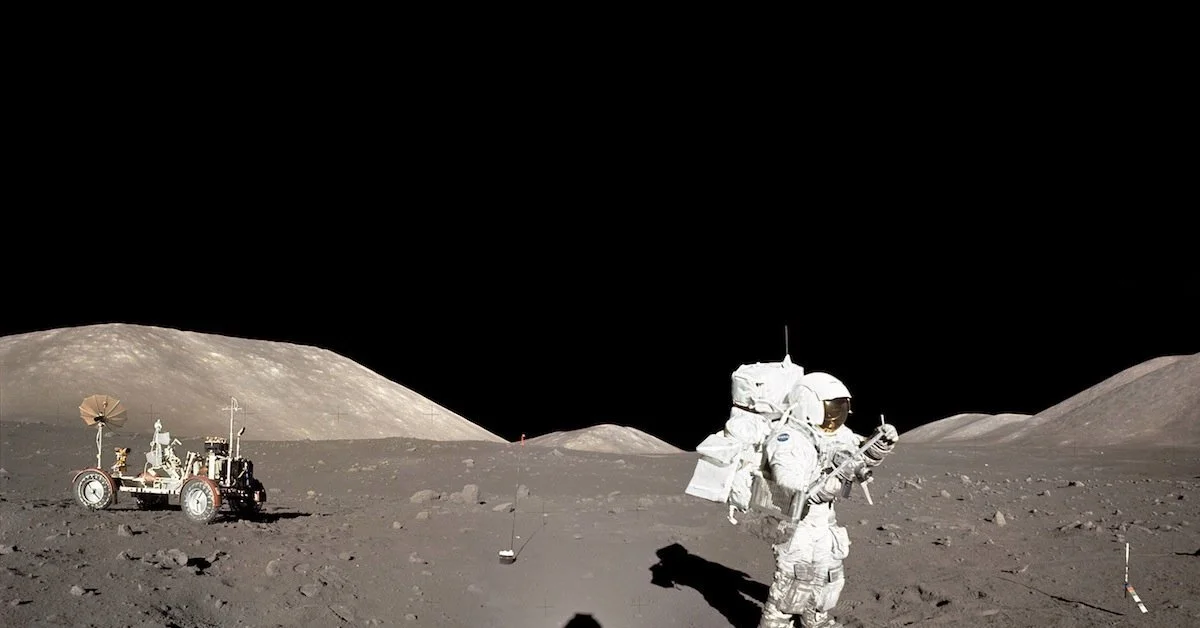“It was overpowering to realize where you were in that moment in space and time and history, and that that’s the Earth, a quarter of a million miles away.” - Eugene Cernan in an interview with Czech Radio when asked what it feels like to view the earth from standing on the moon’s surface.
On December 14, 1972, Apollo 17 left the moon’s surface after a successful three days of extravehicular discovery and exploration. While climbing the ladder into the capsule for the last time, Eugen Cernan looked down at his footprints on the moon’s surface and knew he would not return. He looked on at the earth and said: “We leave as we came, and, God willing, as we shall return, with peace and hope for all mankind. Godspeed the crew of Apollo 17.”. Apollo 17 returned to earth on December 19 and was the last crewed mission to the moon.
Eugene Cernan was born in Chicago, Illinois, and was the son of Rose Cihlar and Andrew Cernan, who were Slovak and Czech descent. Eugene excelled in high school and college, later attending Purdue University. He was a member of several committees and honor societies. After his sophomore year, Eugene accepted a partial Navy ROTC scholarship and served abroad in USS Roanoke while on school break in his junior and senior years. Graduating in 1956, Eugene received a Bachelor of Science degree in electrical engineering.
After college, Eugene knew he wanted more in his military career, enlisted in active duty, and started attending flight training at Whiting Field, Barron Field, Naval Air Station Corpus Christi, and Naval Air Station Memphis. Soon after completing his assignment in Miramar, California, Eugene completed his education in 1963 at the U.S Naval Postgraduate School with a Masters of Science degree in aeronautical engineering.
In an interview after he retired, Eugene credited much of his NASA career in his experience and passion as a naval aviator.
NASA selected Cernan in October 1963, as one of the third groups of astronauts to participate in the Gemini and Apollo space programs. Eugene and 14 other men were chosen to participate, were dedicated to their work and training the Apollo and Gemini missions. Everyone working on the NASA space missions was focused on America’s race to the moon. While they were all dedicated and very proud of their work, they made sacrifices in family and other aspects of their lives.
In his NASA career, Eugene Cernan would leave his mark in history by flying three times in space and making two flights to the moon. He piloted the Gemini 9 mission, and in 1969 he was a part of the Apollo 10 mission. This mission became the test run for the Apollo 11 mission, which helped Neil Armstrong walk on the moon.
Eugene Cernan Lunar Module Pilot and Commander (Left), and Ronald Evans Command Module Pilot (Right)
In December 1972, Eugene concluded his NASA career as commander of the last human mission to the moon. While on this last mission, the crew captured this iconic photo of the earth without a dark cast and fully illuminated.
Apollo 17 crew spent a record-breaking three days on the moon’s surface as well as other remarkable work, including seismic testing and lunar mapping, as many at NASA knew it would be a while before humans would ever return to the moon. On the last day of the lunar landing, Eugene kneeled and wrote his daughter’s initials on the moon’s surface.
After his death on January 16, 2017, many remembered Cernan and his hard work in his career and passions. He continued to fly planes for much of his retired life and remained relatively active in the community. He wanted the world to not give up on lading on the moon. He wanted to share his experiences with everyone.
The Apollo 17 module is now on display at the Johnson space center Houston and other artifacts from the mission. His legacy will also be remembered at The National Czech and Slovak Museum and Library and NCSML National Advisory Council from his involvement. The Czech Center Museum Houston also reflected Captain Cernan and his dedication to his work and passion.
“We leave as we came, and, God willing, we shall return, with peace and hope for all mankind.” -- Cernan’s closing words on leaving the moon at the end of Apollo 17
Written by Karlin Lojo





